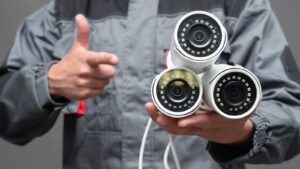Maintaining or constructing healthy road infrastructure is essential for the public’s safety. This is heightened by the fact that the global demand for infrastructure is expected to grow in 30 years, as noted in an article by Deloitte. The reasons for this are two-fold, including the increasing population growth and the rise in urbanisation. However, the construction and infrastructure industry faces major structural issues and risks. Governments have therefore encouraged companies to use the advanced technology of Artificial Intelligence (AI) to strengthen road infrastructures and extend their lifecycle.
AI is an umbrella term for algorithmic and computer science techniques through which data is processed, allowing it to learn from past experiences, adapt and help road managers to reach decisions. This means AI does not refer to incorporating one device but refers to a series of approaches and methods that display intelligent behaviour via advanced technologies. Such devices analyse their environments and take actions whilst keeping managers in the loop. The OECD AI Experts Group has defined AI as “a machine-based system that can, for a given set of human-defined objectives, make predictions, recommendations or decisions influencing real or virtual environments.” In short, AI technology helps make transportation more reliable, safer, efficient and cleaner.
How Does AI Extend the Life Cycle of Road Infrastructure?
According to a discussion paper published by McKinsey Global Institute in 2018, the global economic output could reach USD trillion by 2030 if AI is integrated. The advantages AI poses to the transportation industry are not limited to the smart features in the automotive industry. It is far broader, making significant contributions to extending the life cycle of road infrastructures. Here are two main benefits countries can enjoy by strengthening the road infrastructure with AI technology:
Improve Road Construction Safety
Road infrastructure may not retain the quality it had when it was built for a lifetime. Over time, it deteriorates due to various factors, including environmental, traffic, weather conditions, and natural disasters, through which public safety is at risk. To avoid such risks and maintain the quality of infrastructure, it is necessary to carry out road inspections whenever possible. Imagine that there is an impending risk that is about to occur. There will be no prompt action until a human specialist detects it in inspection, and a report is made and submitted to the asset manager for decision making. Hence, it is a time-consuming and costly matter. However, with AI, daily road infrastructure inspections can be automated efficiently. With CCTV cameras and the Internet of Things (IoT) sensors, AI technology will monitor and detect any potholes, edge defects, simple cracks, and network cracks on the road surfaces and instantly notify managers. This way, maintenance teams can be dispatched as fast as possible to take preventive measures.
Moreover, AI also predicts accidents and suggests ways to improve them based on road user movements. The AI-infused cameras can detect road conflicts, including vehicle collisions and pedestrian crossing prediction. Data received through such applications can later be transmitted to traffic systems, which can help reduce road accidents.
Help Governments Reduce Net Zero Emissions
With the increasing levels of CO2 emitted into the environment, there is a need to ensure roads are constructed sustainably. This includes reconsidering the typical raw materials that go into road construction whilst building strong infrastructures. Road managers can design the infrastructure in advance and consider its impact on the environment virtually with Digital Twins, a type of AI technology, without having to construct it.
According to an article by Forbes, AI feeds on data from weather forecasting systems to warn impending disasters with 89 per cent to 99 per cent accuracy. This helps scientists and road managers prepare for natural disasters and implement a contingency plan. From testing out different raw materials to monitoring their durability and energy levels, road managers can be in control of any emissions released into the environment.
A Sustainable Road Future With AI Technology
The significance of extending the road infrastructure lifecycle is seen by the environmental and safety benefits each country can gain. As the world is rapidly progressing and every town transforms into an urbanised city, it is pivotal that steps are taken to ensure strong and reliable infrastructures are put in place. Unlock the advantages of AI technology by integrating it into your transportation assets today.







